Maltese terrier cross with enlarged abdomen
Signalment:
- 12-year-old female neutered Maltese Terrier cross
Presenting complaint:
- abdominal enlargement, lethargy, inappetance for 3 months. Your physical exam shows an obviously distended abdomen with a very large (>10 cm diameter) firm palpable abdominal mass, mucous membranes pink but paler than normal, periodontal disease. Otherwise clinical exam within normal limits, and she seems surprisingly alert and responsive. The clients say the abdominal enlargement has only happened in the past month.
1 |
What do you do next? |
| Abdominal ultrasound report |
|---|
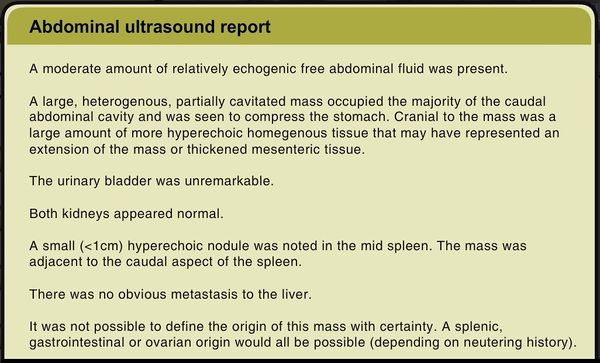
|
| PCV and TP report |
|---|

|
| Urinalysis report |
|---|

|
2 |
Review the abdominal ultrasound report, the packed cell volume and total protein report and the urinalysis report. What do you do next? |
| Haematology report |
|---|
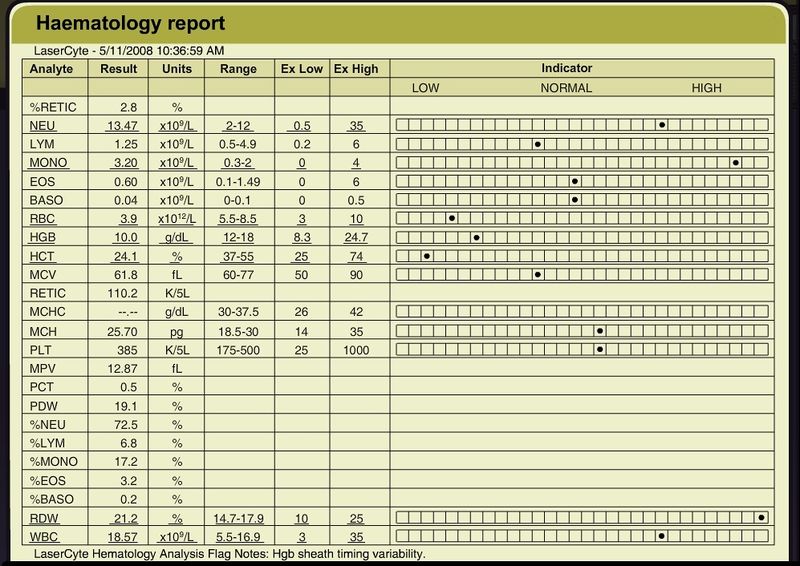
|
| Serum biochemistry report |
|---|
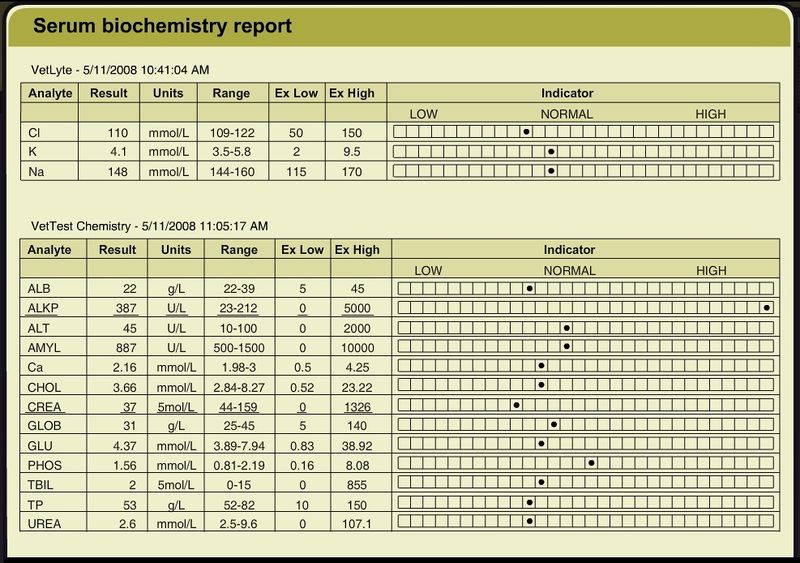
|
| Blood donor qualities | |
|---|---|
| a) | healthy, receives yearly physical exam, CBC, UA, biochemistry |
| b) | not been the recipient of a transfusion |
| c) | over 25kg |
| d) | negative for DEA1.1 |
| e) | fully vaccinated, heartworm negative, dogs receiving heartworm prophylaxis |
| f) | screened for Ehrlichia and Babesia (in areas where these occur |
3 |
Your next tests are haematology and serum biochemistry. You give the option of referral for surgery but the clients decline. You are not sure what to expect at surgery so you hire a suction unit and electrocautery unit from a drug company. You ask the clients to bring in their friend's dog so you have a whole blood transfusion on hand if needed. What qualities should you look for in choosing a blood donor for your surgical patient? (Select from the table above.) |
4 |
You have organized your blood transfusion and are now ready for surgery. Then you realize that you have forgotten to do something. What is it? |
| Results |
|---|
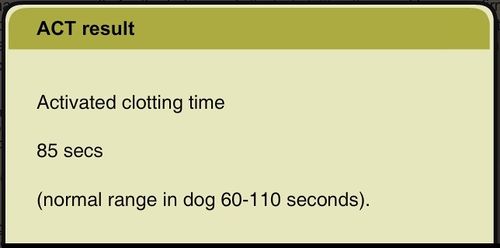
|
| Anaesthetic considerations | |
|---|---|
| a) | Tilting the patient so that the head is slightly higher than the abdomen to allow the mass to fall away from the chest and enable adequate chest expansion |
| b) | Blood pressure readings before, during and after surgery |
| c) | Warming the patient intraoperatively as she is small and will become cold quickly |
| d) | Ensuring intravenous fluid support and potentially the use of colloids for blood pressure support |
| e) | Minimizing blood loss |
| f) | Fast, efficient surgical technique |
5 |
You have your results for the in-house Activated clotting time and have confirmed that the thoracic radiographs were unremarkable. You are ready for surgery and about to anaesthetize the patient. What anaesthetic considerations run through your head? (Select from the table above.)] |
6 |
You perform the surgery and fortunately it is a splenic mass rather than a huge liver mass. The mass is not ruptured and is removed via splenectomy. The abdomen is closed, she recovers remarkably well and is eating ravenously for the first time in months a few hours after surgery. What is the two-thirds rule of splenic masses? |
7 |
If this splenic mass was a haemangiosarcoma and had ruptured, what stage would it be and why? |
8 |
If the tumour was found at surgery to be a massive liver tumour (isolated to one lobe, usually low-grade hepatocellular carcinoma), what is the prognosis with complete surgical resection? |
9 |
If the mass was found to be a massive liver tumour, what piece of surgical equipment could prove most invaluable? |
10 |
Your patient is now in recovery and sleeping well. Your client wants to take her home immediately. Why does this patient still need close monitoring and what piece of equipment is essential for this postoperative patient? |
11 |
You monitor the electrocardiograph and notice she has developed a significant arrhythmia. What is the commonest arrhythmia seen in canine patients after splenic surgery? |
12 |
How would you manage your patient’s arrhythmia? |
| Histopathology Report |
|---|
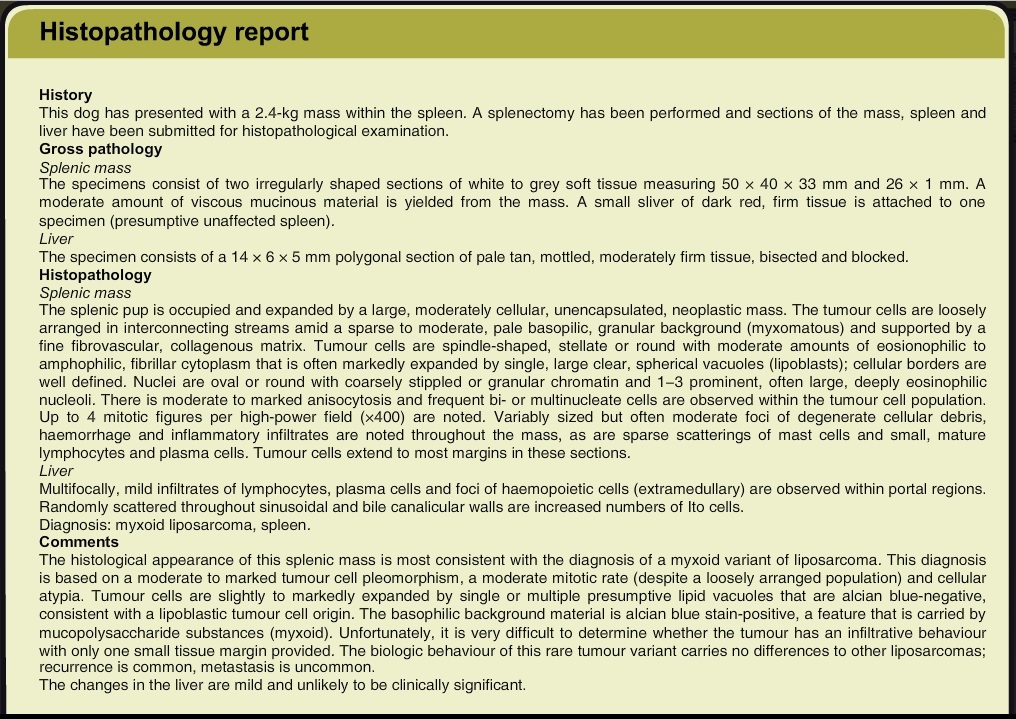
|
13 |
You send samples of the mass off to histopathology. Now that you have the results of histology, what do you do next? |
14 |
With respect to other splenic masses seen in dogs, what do we understand by the term ‘nodular fibrohistiocytic proliferation’? |
15 |
Infiltrative disease of the spleen, e.g. lymphoma or metastatic mast cell tumour, can appear ultrasonographically like what non-neoplastic condition affecting the spleen? |
16 |
What are the most common tumours seen in the spleen of cats? |
17 |
In cats, what is the treatment of choice for splenic mast cell tumour and what is the prognosis with treatment? |
| This resource was adapted from North and Banks, Small Animal Oncology provided by Elsevier Health Sciences as part of the PublishOER Project. | 
|